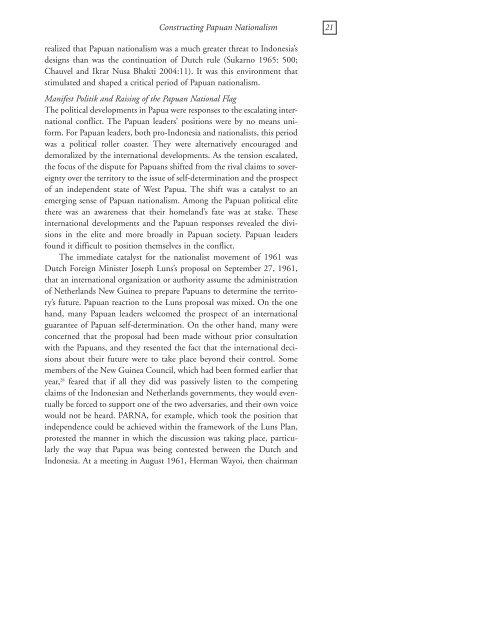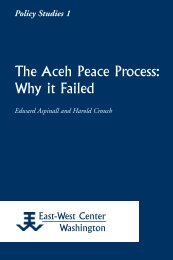Constructing Papuan Nationalism: History, Ethnicity ... - ScholarSpace
Constructing Papuan Nationalism: History, Ethnicity ... - ScholarSpace
Constructing Papuan Nationalism: History, Ethnicity ... - ScholarSpace
- No tags were found...
Create successful ePaper yourself
Turn your PDF publications into a flip-book with our unique Google optimized e-Paper software.
<strong>Constructing</strong> <strong>Papuan</strong> <strong>Nationalism</strong> 21realized that <strong>Papuan</strong> nationalism was a much greater threat to Indonesia’sdesigns than was the continuation of Dutch rule (Sukarno 1965: 500;Chauvel and Ikrar Nusa Bhakti 2004:11). It was this environment thatstimulated and shaped a critical period of <strong>Papuan</strong> nationalism.Manifest Politik and Raising of the <strong>Papuan</strong> National FlagThe political developments in Papua were responses to the escalating internationalconflict. The <strong>Papuan</strong> leaders’ positions were by no means uniform.For <strong>Papuan</strong> leaders, both pro-Indonesia and nationalists, this periodwas a political roller coaster. They were alternatively encouraged anddemoralized by the international developments. As the tension escalated,the focus of the dispute for <strong>Papuan</strong>s shifted from the rival claims to sovereigntyover the territory to the issue of self-determination and the prospectof an independent state of West Papua. The shift was a catalyst to anemerging sense of <strong>Papuan</strong> nationalism. Among the <strong>Papuan</strong> political elitethere was an awareness that their homeland’s fate was at stake. Theseinternational developments and the <strong>Papuan</strong> responses revealed the divisionsin the elite and more broadly in <strong>Papuan</strong> society. <strong>Papuan</strong> leadersfound it difficult to position themselves in the conflict.The immediate catalyst for the nationalist movement of 1961 wasDutch Foreign Minister Joseph Luns’s proposal on September 27, 1961,that an international organization or authority assume the administrationof Netherlands New Guinea to prepare <strong>Papuan</strong>s to determine the territory’sfuture. <strong>Papuan</strong> reaction to the Luns proposal was mixed. On the onehand, many <strong>Papuan</strong> leaders welcomed the prospect of an internationalguarantee of <strong>Papuan</strong> self-determination. On the other hand, many wereconcerned that the proposal had been made without prior consultationwith the <strong>Papuan</strong>s, and they resented the fact that the international decisionsabout their future were to take place beyond their control. Somemembers of the New Guinea Council, which had been formed earlier thatyear, 28 feared that if all they did was passively listen to the competingclaims of the Indonesian and Netherlands governments, they would eventuallybe forced to support one of the two adversaries, and their own voicewould not be heard. PARNA, for example, which took the position thatindependence could be achieved within the framework of the Luns Plan,protested the manner in which the discussion was taking place, particularlythe way that Papua was being contested between the Dutch andIndonesia. At a meeting in August 1961, Herman Wayoi, then chairman
















